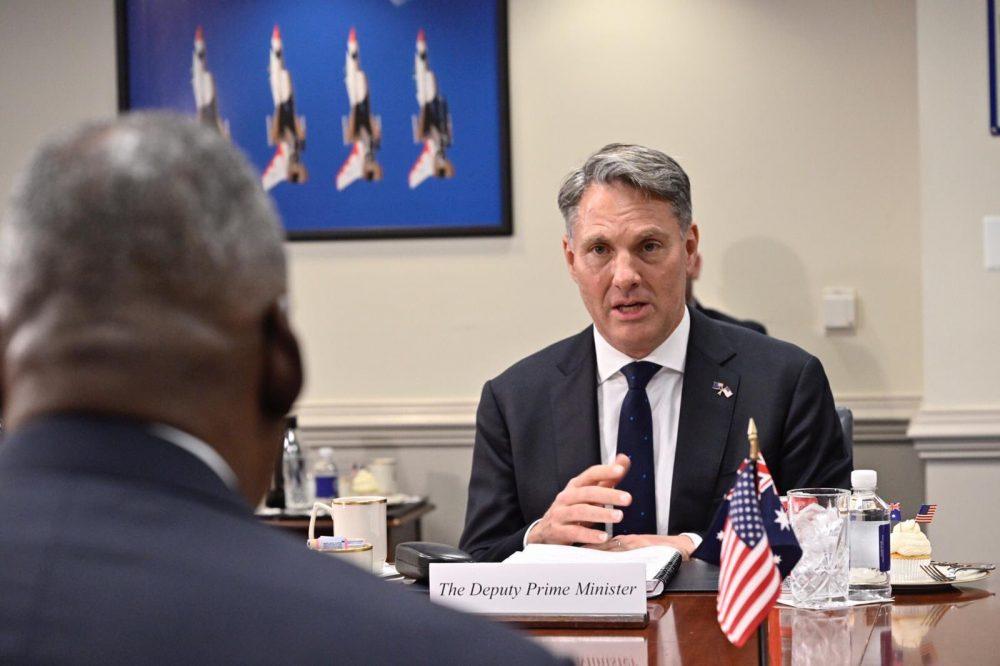
Washington was the last of the Quad capitals that Richard Marles visited in his opening diplomatic salvo as Australia’s deputy prime minister and defence minister. But, as far as defence matters are concerned, the agenda that he took to Washington was arguably the most ambitious and complex of all.
Of course, Marles’s meeting with US Defense Secretary Lloyd Austin and his team was not his first. The two met twice on the sidelines of the Shangri-La Dialogue in Singapore last month. But a dedicated bilateral visit offered some obvious advantages, particularly so early in the new Australian government’s tenure. For one, it allowed top officials to explore issues of common interest in more depth than at engagements on the sidelines of regional forums. The rest of Marles’s visit provided opportunities for direct engagement with other important parts of the US system, including other government departments, the wider strategic and defence policy community, Congress, and defence industry entities.
If Marles’s excellent address at the Center for Strategic and International Studies was a tone-setter, then three words capture the essence of the agenda Marles would have sought to prosecute with Washington: integrate, integrate, integrate.
Importantly, Marles repeatedly made clear over the course of his visit that his government wasn’t looking to reinvent the wheel when it came to the US–Australia alliance’s defence integration program. Rather, his message was that the wheel needs to spin faster, whether in advancing defence technology cooperation or accelerating ambitious force posture plans—both longstanding objectives held by successive Australian governments.
For instance, at CSIS Marles flagged his intention to propose specific measures to streamline cooperation through the US national technology and industrial base, or NTIB. This mechanism is intended to facilitate greater defence innovation and easier technology sharing between the US and its most trusted allies, Australia included. Yet prohibitive export-control regimes and bureaucratic misalignment have prevented the NTIB from delivering on its promise as a veritable defence free-trade zone, barriers that continue to hamper Australian efforts to develop sovereign capabilities with US help, such as the guided weapons and explosive ordnance enterprise. It’s unclear exactly what reforms Marles proposed to his interlocutors at the Pentagon. But in making this a centrepiece for his engagement with American counterparts, Marles continued with the proactive efforts of former defence ministers Peter Dutton and Linda Reynolds to ensure that the NTIB remains at the top of the bilateral agenda.
Efforts to get the NTIB working properly feed directly into another defence integration priority for the new government: AUKUS. Indeed, one of the NTIB’s chief architects has warned that, without urgent reform, longstanding collaboration could yet sink technology co-development and transfer projects flagged under AUKUS. Australia’s future nuclear-powered submarines, of course, remain the big-ticket item, and Marles indicated before his departure that accelerating the subs’ delivery timeline would be central to his discussions in DC. But Australia is looking for substantial advanced-capability pay-offs from AUKUS much earlier than the 2040s. Marles’s emphasis on the need for Australia to acquire long-range strike, advanced cyber capabilities and so-called area-denial systems like uncrewed underwater systems underscored that perspective, and will undoubtedly have been close to the top of the agenda in his meetings with senior US defence officials.
However, implementing AUKUS and the NTIB isn’t just about maximising benefits for Australia. Indeed, at CSIS Marles argued that Australia’s goal was to ‘supplement and strengthen US industry and [shared] supply chains’ by providing ‘a trusted second source’ for critical items like precision munitions for both militaries. In that sense, the alliance’s defence industrial and technology integration initiatives are closely tied to the expanded force posture initiatives (EFPIs) announced at AUSMIN last year, which are also intended to better integrate Australian and US defence forces. Marles made clear at the Australian–American Leadership Dialogue that he sees AUKUS as, ideally, facilitating the sort of ‘seamless’ defence industrial integration that would truly reflect the interoperability of US and Australian forces, and make Australia ‘a much more potent and effective’ security partner in the region.
With EFPI implementation high on the agenda, the government’s planned force posture review provides an opportunity to better integrate Australian forces with the US and prepare them for the sorts of ‘high‑end warfighting and combined military operations’ flagged in last year’s AUSMIN communiqué. As Marles argued at CSIS, timely progress on the EFPIs will be crucial if the alliance is to ‘move beyond interoperability to interchangeability’. Plans to develop a shared logistics, maintenance and sustainment capability as part of the EFPIs to support high-intensity and high-end operations neatly capture this dynamic.
However, an expanding aperture for the US military presence in Australia should also prompt Canberra and Washington to deepen their joint strategic planning—to better ‘share the burden of strategic thought’, as Marles put it. This is something that alliance practitioners have long called for as part of wider efforts to modernise the alliance for new and emerging deterrence challenges. Of course, Taiwan has dominated much of the public discussion on this point. But the growing number of close encounters between Australian and Chinese aircraft and warships across the region, and concerns that Canberra and other regional allies have that such ‘routine’ coercion could escalate into conventional conflict, make this more important than ever—particularly if the EFPIs are to be implemented and leveraged in ways of greatest benefit to Australian interests.
It goes without saying that implementing this integration program—only a part of the wider bilateral agenda—will take more than one successful high-level visit. But Marles’s clear message to Washington that the wheels of integration need to spin faster than ever before is cause for optimism that the US–Australia alliance can get ‘match-fit’ for defence challenges in the Indo-Pacific.